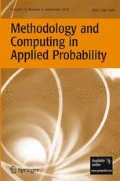Abstract
In this paper, we introduce a methodology for efficiently monitoring a health process that classify the intervention outcome, in two dependent characteristics, as “absolutely successful”, “with minor but acceptable complications” and “unsuccessful due to severe complications”. The monitoring procedure is based on appropriate 2-dimensional scan rules. The run length distribution is acquired by studying the waiting time distribution for the first occurrence of a 2-dimensional scan in a bivariate sequence of trinomial trials. The waiting time distribution is derived through a Markov chain embedding technique. The proposed procedure is applied on two simulated cases while it is tested against a competing method showing an excellent performance.
Similar content being viewed by others
References
Antzoulakos DL, Rakitzis AC (2010) Runs rules schemes for monitoring process variability. J Appl Stat 37(7):1231–1247
Balakrishnan N, Koutras MV (2009) Runs and Scans with Applications. Wiley, New York
Balakrishnan N, Bersimis S, Koutras MV (2009) Run and frequency quota rules in process monitoring and acceptance sampling. J Qual Technol 41(1):66–81
Chakraborti S, Eryilmaz S (2007) A nonparametric shewhart-type signed-rank control chart based on runs. Communications in Statistics - Theory and Methods, vol 36
Champ CW, Woodall WH (1987) Exact results for shewhart control charts with supplementary runs rules. Technometrics 29(4):393–399
Cook RJ (1994) Interim monitoring of bivariate responses using repeated confidence intervals. Control Clin Trials 15(3):187–200
Cook RJ (1996) Coupled error spending functions for bivariate sequential tests. Biometrics 52(2):442–450
Cook RJ, Farewell VT (1995) Guidelines for monitoring efficacy and toxicity in clinical trials. Biometrics 50(4):1146–1152
Costa AFB, de Magalhães MS, Epprecht EK (2009) Mnitoring the process mean and variance using a synthetic control chart with two-stage testing. Int J Prod Res 18:5067–5086
de Leval MR, François K, Bull C, Brawn W, Spiegelhalter D (1994) Analysis of a cluster of surgical failures. application to a series of neonatal arterial switch operations. J Thorac Cardiovasc Surg 107(3):914–924
Jakobson T, Karjagin J, Vipp L, Padar M, Parik AH, Starkopf L, Kern H, Tammik O, Starkopf J (2014) Postoperative complications and mortality after major gastrointestinal surgery. Medicina 50(2):111–117
Koutras MV, Bersimis S, Maravelakis PE (2006) Improving the performance of the chi-square control chart via runs rules. Methodol Comput Appl Probab 8(3):409–426
Koutras MV, Bersimis S, Maravelakis PE (2007) Statistical process control using shewhart control charts with supplementary runs rules. Methodol Comput Appl Probab 9(2):207–224
Koutras MV, Maravelakis PE, Bersimis S (2008) Techniques for controlling bivariate grouped observations. J Multivar Anal 99(7):1474–1480
Li J, Tsung F, Zou C (2014) Multivariate binomial/multinomial control chart. IIE Trans 46(5):526–542
Maleki MR, Amiri A (2015) Simultaneous monitoring of multivariate-attribute process mean and variability using artificial neural networks. J Quality Eng Prod Optim 1(1):43–54
Montgomery DC (2005) Introduction to Statistical Quality Control. Wiley, New York
Rakitzis AC, Antzoulakos DL (2011) Chi-square control charts with runs rules. Methodol Comput Appl Probab 13(4):657–669
Roche JJ, Wenn RT, Sahota O, Moran CG (2005) Effect of comorbidities and postoperative complications on mortality after hip fracture in elderly people: prospective observational cohort study. Br Med J 331(7529):1374
Schatz R, Egger S, Platzer A (2011) Poor, good enough or even better? bridging the gap between acceptability and qoe of mobile broadband data services. In: Proceedings of the 2011 IEEE International Conference on Communications, pages 1–6, Kyoto
Steiner SH, Cook RJ, Farewell VT (1999) Monitoring paired binary surgical outcomes using cumulative sum charts. Stat Med 18(1):69–86
Story DA (2013) Postoperative complications in australia and new zealand (the reason study). Perio Med 2:16
Topalidou E, Psarakis S (2009) Review of multinomial and multi-attribute quality control charts. Qual Reliab Eng Int 25(7):773–804
Woodall WH (1997) Control charting based on attribute data: Bibliography and review. J Qual Technol 29(2):172–183
Author information
Authors and Affiliations
Corresponding author
Rights and permissions
About this article
Cite this article
Bersimis, S., Sachlas, A. & Castagliola, P. Controlling Bivariate Categorical Processes using Scan Rules. Methodol Comput Appl Probab 19, 1135–1149 (2017). https://doi.org/10.1007/s11009-016-9508-5
Received:
Revised:
Accepted:
Published:
Issue Date:
DOI: https://doi.org/10.1007/s11009-016-9508-5
Keywords
- Multi-attribute processes
- Markov chain embeddable random variables
- Multivariate statistical process control
- Waiting time distributions




